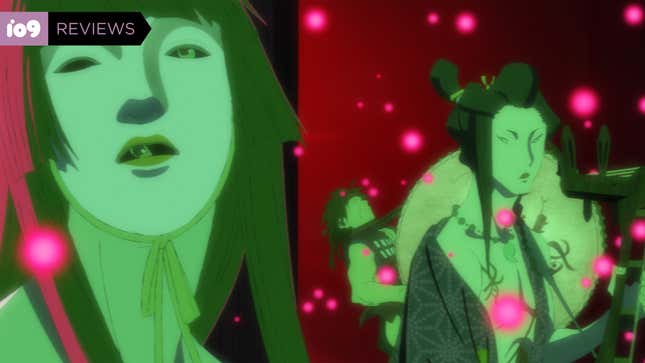
From acclaimed director Masaaki Yuasa (Crybaby Devilman, Lu Over the Wall, Keep Your Hands Off Eizouken!), comes Inu-Oh, a historical anachronism that blends glam rock with Noh theater, creating a delightfully flamboyant and vibrant film that merges myth, history, and music. The film is eccentric and expansive, following the semi-folkloric artist Tomona from a child to his time as biwa priest, and finally to a rock star in his own right.
Along the way to fame, Tomona breaks from the order of biwa-playing priests and sets out to find his own style, helped in no small part by the mysterious singer/dancer/frontman, Inu-Oh. Although Inu-Oh was cursed with supernatural body differences, as he performs parts of himself return to a more human-like shape. He never thinks of himself as being less than anyone else, and doesn’t let his ten-foot arm or mouth or back covered in scales stop him from performing.
Eventually, Tomona and Inu-Oh make it into the big leagues, scoring a performance in front of the local magistrate. This is the big finale, the whole film has been preparing you to take in the magical, mystical, genre-defying moment for these two artists. And as these two rock gods jam out on stage, they come into their own, fully realizing the radical nature of their work, pushing the boundaries of storytelling so far that they become a threat.
Throughout the film there is a repeated theme of censorship and authority, as people attempt to control art and determine what stories–and what histories–are worthy of being told. From artist sects to audiences, to members of the social elite, everyone around Tomona and Inu-Oh wants to be able to dictate which art is right and which is wrong. As people attempt to control artistic interpretations, it only becomes more and more difficult to contain them.

Like most of Yuasa’s work, the visuals in Inu-Oh are stunning, and exceptionally paired to the storyline that it’s trying to convey. It creates two distinct worlds; the brutal real-world that blinded Tomona as a child and the magical one that Inu-Oh brings to life with his stories. As the pair hype each other up, creating more and more havoc, and more and more and music together, the world around them never changes—but they still make music. The outcome of their art is internal, driven by the changes that the artists themselves feel. There’s a part of this commentary that makes it seem as if art is futile, but it ultimately comes out like a reminder that art must be made for yourself first—Tomona and Inu-Oh belong to their stories, as much as their stories belong to them in turn.
The plot of Inu-Oh is really a story of what happens in between performances. It’s an elusive thing, a melody in the background of the music. What’s most captivating about the movie however, is the art and storytelling that occurs during the recitals. There’s a reverence for the importance of an artist’s vision, and we understand that what’s important to the film’s audience and what’s important to Tomona and Inu-Oh’s audience are perhaps two different things. Inu-Oh prioritizes itself, its own story, over and over, and that’s what really sets this film apart. It’s got the kind of referential, tongue in cheek nods to the people at home, but really it’s performing for the audience in front of their animated stage.
Inu-Oh is also concerned about another kind of performance: Tomona crosses the boundaries of tradition in both his musical stylings and his sartorial choices. In Tomona, Yuasa has channeled icons like Iggy Pop, David Bowie, and Freddie Mercury, and he pushes back against traditional roles in more ways than one. Besides being a transgressive artist, he also wears women’s clothing, puts on makeup, wears his hair down, becoming less and less concerned with any kind of perimeters that surround gender, making it clear that he is simply doing what feels right for him.
This movie is about speaking the truth and basking in the consequences all along the way. Tomona and Inu-Oh confront censorship like a badge of honor, and revel in the right to speak to a shared history that most people would like to see papered over. But it’s also about selling out, about trading your story for comfort, and the radical who would rather die than be tamed. It’s a heady mix of the surreal and the grounded struggles of making art itself--and the sometimes electric sensation that can come along the way in spite of all the struggles faced creating it.
Inu-Oh will open in select theaters August 12.
Want more io9 news? Check out when to expect the latest Marvel and Star Wars releases, what’s next for the DC Universe on film and TV, and everything you need to know about House of the Dragon and Lord of the Rings: The Rings of Power.